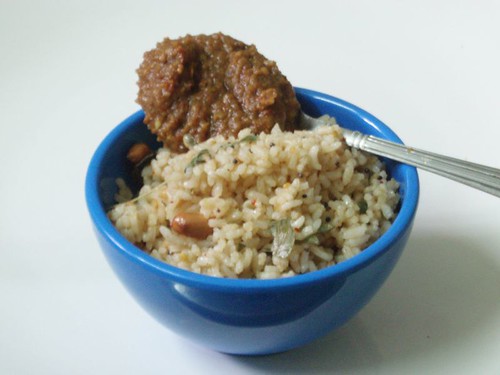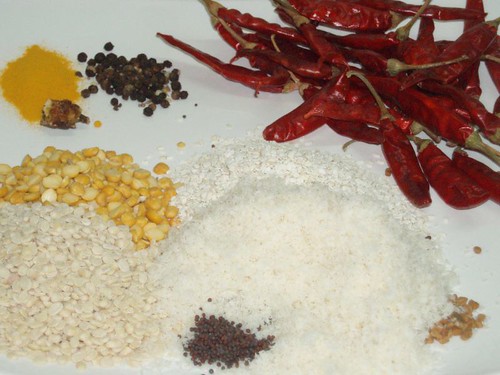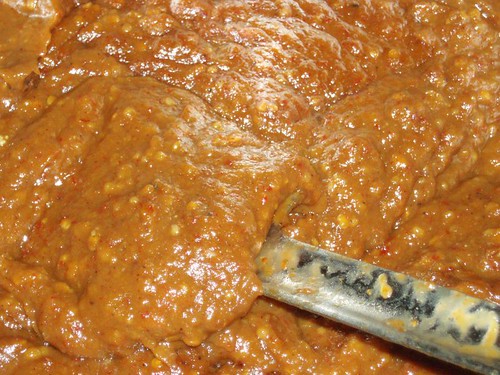Now that wouldn’t do, even though it was a highly practical recipe for a rational, everyday quantity of rice. Karnataka cuisine, bar the Mangalorean/Konkan style, is as undersold as Oriya cuisine so it has to be as authentic as possible, at least in my ’umble blog, so there began the task of preparing myself mentally to soak, squeeze and boil down the 1/4th kilo of tamarind that all the seemingly Karnataka-style recipes called for. (I didn’t want to scale down for authenticity’s sake, am bad at Maths.)
A tad anaemic, but that can be addressed by adding more concentrate/more turmeric during the final tempering!
In fact, I’ve no doubt that this is a Karnataka recipe as it’s called Mysore Puliyogare, and it also says that the author was raised in that State but it shall remain unnamed because the instructions started unraveling halfway through the recipe and it was left to yours truly to take it upon herself to put two and two together and finish it off!
As it happened, the finished product had nothing in common with the other one I mentioned, but was very different from the pulihora we make at home. I had never tried my hand at chintapandu pulihora (tamarind rice), often a dirty yellow-brown whose sourness set my teeth on edge almost everywhere I encountered it, but nimmakaya pulihora (lemon rice) and its mango counterpart were a different kettle of fish altogether (now, fish and pulihora is an interesting thought, but I digress).
The difference between our home’s pulihora and others’ was that we wouldn’t put any nuts in ours, tamarind, lemon or mango, but with this dish, that’s going to change, even though the recipe didn’t mention any. Does that take away from the Mysoreness of the pulihora? I don’t know. I had to ask a friend how to use the puliyogare concentrate, and with a wicked glint in her eye, she explained.
“Spread the cooked rice in a plate and cool it. Mix gingelly (sesame) oil with it, so much that your hand also becomes nice and oily (the glint appeared here), and mix the concentrate with the rice.”
“But what about the nuts?” I asked.
“Well, aren’t they in the concentrate already?” she asked.
No, I said. I still don’t know when to include them in the concentrate but I’m going to fry a bit of them separately, along with some more mustard seed, black gram and curry leaf, and put them in the rice.
Here’s the recipe, then!
The tamarind and coriander powder/seeds are not seen
Tamarind: ¼ kg/250 gm
Coriander powder: 1 tbsp (the book recommended 1 tbsp of coriander seeds, to be fried with the rest of the ingredients in oil)
Peppercorns: 1 tsp
Fenugreek seeds: ¼ tsp
Mustard seeds: ¼ tsp
Asafoetida: A chip/crystal the size of a tamarind seed (could be ¼ tsp, or ½ tsp of the powdered variety)
Salt: 1-1/2 tbsp (I used iodised crystal salt)
Dry red chillies: 30, stalks off
Jaggery: 50 gm (the book recommended 100 gm)
Black gram dal, split, husked: 2 tbsp
Bengal gram dal, split, husked: 2 tbsp
Turmeric: 1 tsp
White sesame seeds: 3 tbsp
Dessicated coconut: 3 tbsp (the book recommended ¼ of coconut but I’ve seen other recipes include dry coconut in Karnataka versions)
Sesame/gingelly oil: 7-8 tsp (the book doesn’t specify)
Wash tamarind. Soak tamarind, salt and jaggery in water an hour ahead.
After an hour or more, squeeze the tamarind to extract the juice, strain into a cooking vessel. Discard the pulp.
Boil this juice – it took more than an hour for all the water to evaporate and the concentrate to thicken. In fact, I kept adding water as I 'kneaded' the tamarind for easy pulp extraction, but if you can do it with less, well and good.
Barring coriander powder, fry all the remaining ingredients in oil till a nice aroma comes off the pan. Make sure the red chillies don’t blacken.
Whiz the fried mixture along with coriander powder to a ‘pasty’ powder (don’t add any water, but the oil will make it wet) in a mixer/grinder.
As the tamarind concentrate begins to thicken, begin to simmer it.
Just before you remove it from the fire, add the spice mix to the pan. Stir well and take off fire.
Glorious, isn't it?
Cool completely and bottle. Put it in the fridge.
This amount was recommended for 3.5 kilos of rice. The rice should be plain, non-Basmati, non-scented rice.
To use the tamarind concentrate, mix it with cooked and cooled rice to which some oil and turmeric powder has been added. Temper it with mustard seeds, some black gram dal, curry leaves and nuts fried in a bit of sesame oil.
My concentrate has a lovely aroma of asafoetida and sesame oil, not to mention the flavour of the dry red chilli!
Here's more info on pulihora/puliyogare.
Here's a rava version and a semia version and a carrot version
RCI-Karnataka Puliyogare/pulihora/tamarind rice



I don't know how to include the nuts in the concentrate, but I would do the same thing you did to include the nuts. There is no puliyogare without nuts!!!
ReplyDeleteI use the store-bought version, and add some extra nuts while frying the powder in oil... :).
I love puliyogare :). and i am going to try your recipe soon!
ReplyDeleteOooh! sra, you are psychic gal!! I just asked Lakshmi of yum blog to make Hulianna for me and here you are with it my sweet soul sistah!Hahaha!
ReplyDeleteLooks very authentic just my mom makes and yes,little anemic but hey, you can always add some more of that glorious stuff!:D
Thank you so much sra for taking all that trouble,hope you loved the Hulianna too. I am making your way next week,got to rest my rest some more and get the green signal from the doc,then I am good to go.
Hope you are having a great weekend,we just came back from grocery shopping, grapes, Plantains,bananas amd what not, you know! ;D
yum.. love pulihora and keeping them in bottles for ready use on later days is just perfect...liked the way ur blue bowl looked esp. with that start exterior..brought out the blueness??
ReplyDeletesimply Tangycious!! the idea of storing it in fridge sound great. lovely recipe.
ReplyDeleteSra, that first photo is GORGEOUS! :) I could eat it off my screen!
ReplyDeleteGlorious does not begin to describe it!
ReplyDeleteSig, sister of my soul, you said it!
ReplyDeleteMusical, hope you make it more efficiently than I did anyway - all that squeezing and soaking and boiling took me three hours!
Asha, I quite liked the result.
Rajitha, you liked the picture? Thanks. I thought I failed to take a good one.
Sharmi, yes, most people claim they don't even need to put it in the fridge.
Shyam, really? Thanks.
Cynthia, the photo's more attractive than the real-life concentrate.
WOW....Very creative idea and new for me....I nerve heard about this...And I like you say not use any branded rice but simple rice for nice original Dish of Karnataka. Definitely this is rocking entry for RCI-event my dear.
ReplyDeleteAnd I thought Tamarind Rice was an easy dish, this sounds pretty complex !!!
ReplyDeleteSo you went nuts :)
this looks wonderful. i've never made tamarind rice from scratch. MTR to the rescue. however your version looks very alluring.
ReplyDeleteJest feel like grabbing that bowl Sra. My goodness the second photo is mouthwatering. Nice entry. Viji
ReplyDeleteYummy!! Sra, you write so well that you don't need to put any pictures at all! Nuts are important in all rice preparations!
ReplyDeleteSra, meeru too much ga chesaru chala bagundi ,infact karnataka nalla nuvvulu kuda vestaru.I cannot belive thay you don't like chintapandu pulihara.Jwaram gagginda ?
ReplyDeleteAmma's or MTR... never tried on my own... will try :-)
ReplyDeleteKajal, thank you, welcome to my blog!
ReplyDeleteSandeepa, I'm not good with tamarind, so never tried it all these years. It's not complicated but you need to assemble all the ingredients. Reducing the tamarind could take time if you're not adept at using it - I'm not.
Bee, processing the tamarind in this quantity CAN be painful, literally! But it tastes nice.
Viji, thank you.
Jyothsna, thanks so much. Yes, nuts give texture.
Sreelu, jvaram taggindi, computer is dying a slow death, edupu vastondi. Nijame, this became too much, I follow quantities blindly.
Raaga, it's worth trying it once, then we can decide whether to rpt it or not. Btw, a comment meant for Malabar Spice came here, I think.
hi sra,
ReplyDeleteu know what i am great fan of tamarind rice and puliogare. i wonder how they make the powder. with so many failing attempts i simply bring puliogare powder add some more talimpu with more nuts in it and tamarind juice simmer till consistent add to rice. finish. now i will try this way.thank u.
I was looking for one such authentic Gojju, thats what is told by my kannada friend...I love this..
ReplyDeletewow the you have such a nice color! i just love it!
ReplyDeletehey my hubby loves puliyogare and i would make it with the powder from the shops... i would love to try it at home... from scratch... thank u so much sra...
ReplyDeleteRamya, generally commercial ventures dry the paste with machines, I think. I like the powder too, but haven't tasted it in ages.
ReplyDeletePadma, thanks. It's worth the effort.
Roopa, the photo's better than the original, frankly, LOL!
Rachna, this is v different from the commercial stuff - try it!
i just realised i am really hungry :) nice recipe! :)
ReplyDeleteHi Sra,
ReplyDeleteI think coconut gives rich taste to this rice. Nice pictures, Great entry for RCI. Thanks for sharing.
That does look nice indeed...I'm not very familiar with this recipe...know better now :)
ReplyDeleteI have never tried the tamarind puliyogare...made the mango pulihora from sharmi's recipe....and loved it....this one looks very delicious...
ReplyDeleteGlorious indeed!
ReplyDeletePaz
Wow, Sra, what a beautiful color that is! Completely new to me -- I just love this RCI, learning everywhere I look :)
ReplyDeleteNags, hi, welcome to my blog.
ReplyDeleteMT, funnily enough, I could not discern the taste of the coconut in the end product.
Sunita, glad I could help!
Priyanka, it's delicious, and different.
Paz, thanks.
Linda, can't believe this is new to you, I would have thought you'd be a pro at this, given your love for Indian food! :)
one of my kannadiga friend makes pulihora almost the same way .. lovely looking gojju Sra. nice entry.
ReplyDeleteWe have a different way of making puliyogare at home, we fry all the spices in sesame oil, we add turmeric,peanuts and cashews (optional) when the ingredients are sufficiently brown, tamarind pulp is added and boiled till it gets thick and oil is seen on the sides. We add a sprig of curry leaves for added flavour. We dont add jaggery. Nor do we mix boiled rice with sesame oil before adding the puliyogare. It is also better not to store for over ten days. You can mix it directly on to hot rice, it tastes yummy.
ReplyDeleteVery authentic. We prepare in a different way. Will try your version sometime.
ReplyDelete